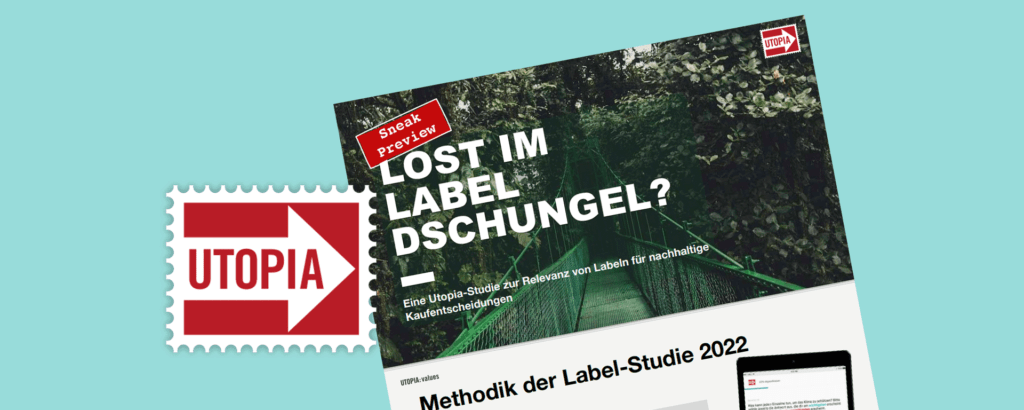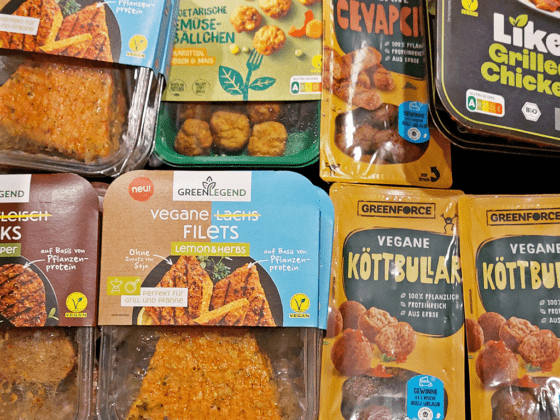Bio and vegan, MSC and Oekotex: on the yogurt pot, the sock wrapper or the glass cleaner – small colorful sustainability seals are now plastered everywhere, often even several next to each other. Can anyone still see through all this? The news portal Utopia, which specializes in sustainability, asked 3002 participants online for a label study on which seals are really useful and helpful when shopping. The results are exciting for both manufacturers and customers – and sometimes quite surprising, too.
Top-10 most important facts from the study
1. Food labels are best known
Most respondents (more than 80 percent) are familiar with nine food seals, six cosmetic seals, and four apparel seals by name or logo. The best-known labels in all three categories are Fairtrade, Ökotest and Stiftung Warentest.
Other very well-known certificates: German organic seal, Demeter, Bioland, Nutriscore, EU organic seal, V-label, Blue Angel.
2. “Speaking” labels are most easily recognized and used
The survey showed: seals that are logical and explain themselves (Fairtrade, Ökotest, Vegan) are the most helpful when shopping. The more abstract the seal, the less familiar it is. Especially in cosmetics and clothing consumers know the higher-level seals such as Fairtrade or Ökotest, but less the actual association seals such as GOTS, BCI or the bunny logos without a name.
3. It is important to know what a seal means
Most important, put some seals on it and the sale will go better…? It doesn’t quite work that way! Only one in six respondents agreed with the statement that they generally find a product with a seal better than without. All others stated that it depends on what kind of seal it is and what properties it assures.
4. Sustainable furniture and banks are difficult to recognize
In most areas, it is already easy for customers to recognize sustainable products. The easiest are food and cosmetics: 81 and 77 percent of respondents, respectively, said they could easily recognize sustainable offerings in these two areas. The situation is different for banks and furniture, where 69 and 73 percent respectively find it difficult to identify such products. In the midfield rank household items, energy and clothing: About half of the respondents easily find sustainable offers in these categories.
5. Customers trust certificates issued by independent organizations more
In the opinion of the respondents, the most trustworthy seals come from environmental protection organizations, associations and NGOs, followed by certificates from government test institutions. 89 and 72 percent of respondents trust these sustainability seals. Only 16 percent trust certificates from private-sector test institutes and just 12 percent of customers trust labels from manufacturers and retailers. 5 percent do not trust any “originator” at all. Here you can read how an environmental protection organization acts against false seals.
6. Five main problems weaken the trust in a seal
The following negative ranking of problems that weaken trust in a label emerged from the survey conducted among Utopia users:
- There are negative headlines about a product with this label.
- The certificate is used by a brand that is not trusted.
- The customer does not even understand what the seal stands for.
- The certificate is not yet known.
- The seal is emblazoned on too many products.
7. Every third German does not care much about sustainability
Those interested in eco issues will probably find this study result quite surprising. In the study, participants were divided into six shopping types according to their responses: the consistent, the green shopper, the thoughtful, the occasional, the carefree and the rejectionist. The study found that 20 percent of the total population in Germany are rejectionists, and a further 17 percent are carefree shoppers. Neither group is particularly interested in sustainability and the corresponding labels. Positive, of course: The “remaining” 63 percent of Germans find sustainability and ecological consumption important.
8. Labels are the most important identifying feature of sustainable products
When shopping, environmentally conscious customers are primarily guided by certificates. They recognize and find sustainable products by the following characteristics:
85 percent by the sustainability label
66 percent by the manufacturer’s information on the product
47 percent by the placement in the area for sustainable products
42 percent by the shelf or the store
32 percent by information and advertising
16 percent by packaging design
11 percent by advice/sales pitch
9. Customers can only think of a handful of seals
The study participants were asked to name sustainability labels for different areas. Result: For food, they could name on average 3.6 seals from memory, for cosmetics even less – only 1.6, and 1.6 again for clothing. In the so-called supported survey, the participants were then asked directly whether they knew this or that seal. Here they knew on average 14.3 food seals, 9.1 certificates for cosmetics and 7.8 for clothing.
10. Environmentally conscious consumers actively research new labels
Greenwashing and fraudulent labels can be quickly seen through by most consumers. The study showed that the more sustainability-savvy the respondents are, the more they inform themselves about labels. In the “greenest” group of consistent consumers, 44 percent of respondents stated that they inform themselves about new certificates. Further 41 percent also research for facts about labels without occasion.
New EU regulation will bring more security for consumers
Summary: Customers trust simple labels with an honest background. The certificates serve as an aid when shopping, especially for food, clothing and cosmetics. The upcoming tightening of the EU consumer protection regulation meets people’s needs: Trust in certificates from independent institutions with an officially approved certification is particularly high. This is exactly what the new regulation brings.
This might also interest you:
Anti-greenwashing regulation: these terms will be on the index in the future
The new EU regulation hits the packaging industry – some will still be surprised
 English
English Deutsch
Deutsch




